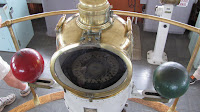 Docked neatly behind the Rock and Roll Hall of Fame and Great Lakes Science Center is a vessel said to have built Cleveland. The William G. Mather (see left, click to enlarge) was a steamship built in 1920s for the Cleveland Cliffs company, which moved tons of iron ore and other materials around the Great Lakes. Today the Mather is a floating museum attached to the Great Lakes Science Center.
Docked neatly behind the Rock and Roll Hall of Fame and Great Lakes Science Center is a vessel said to have built Cleveland. The William G. Mather (see left, click to enlarge) was a steamship built in 1920s for the Cleveland Cliffs company, which moved tons of iron ore and other materials around the Great Lakes. Today the Mather is a floating museum attached to the Great Lakes Science Center.
William G. Mather was an industrialist who served as the head of Cleveland Cliffs for over 50 years. The Mather was the flagship of the company's lake freighters and would bring to Cleveland iron ore from Minnesota which would then be processed into steel at the many plants located in Cleveland. Fittingly, the Mather now looks out over the skyline (see right, click to enlarge) that it helped create and is open to both guided and self-tours.
Navigating the Mather is not a simple task, as there are steep ladders and low overheads despite the cavernous interior that would hold tons of cargo. As the flagship of the fleet, the Mather also could carry several passengers in quarters that aren't too far off cruise ship standards (for the time).

The ship (nautical data here) has two housings between its 600+ foot series of cargo holds. The aft housing is the location of the engine room, galley and state room as well as crew quarters.
The front housing is where passengers, the captain and mates were housed as well as the bridge. The captain's quarters featured two rooms, one being the bedroom and the other an office area (see right, click to enlarge) . There is also private interior stairwell to quickly get the captain up to the bridge without having to be exposed to the weather.

The bridge gives a 360-degree view (see left, click to enlarge) and with surprisingly few navigational needs when compared to touring Navy vessels of similar size.

Standing at the wheel, the compass




looks a little like a science fiction device as the massive bronze hood covering the compass is flanked by two colored iron balls. These two devices help aid in re-calibrating the compass, for when you are carrying tons of iron ore the compass is going to have some issues bearing true north. (see right, click to enlarge)

While the handful of passengers would sail in nicely accommodated cabins, all dining happened aft (see right, click to enlarge). That can make for a tricky walk back along the deck, as the railings were minimal and wire. For crew safety, there is a cable running the length of the ship where sailors would tie into. Should the unexpected happen and a person pitched overboard, the safety lines would keep one from truly going over and into the lake.

The engine room (see left, click to enlarge) is a three story area and must have been quite loud. Originally a pure steam-driven engine, it was later converted to an automated boiler system, the first for any lake freighter. She was also among the first lake vessels to incorporate radar. On the deck above the engine room at the stern of the ship is another set of pilot wheels to be used for navigating the snaking rivers that emptied into the lakes.

The Cuyahoga River is one of those snaking rivers and Great Lakes freighters were designed accordingly. There are propeller-driven blowers, two aft and two forward, that face outward at the water line for navigating these tricky turns. (see left, click to enlarge)

Standing at the rear of the Mather looking out into the lake, one can see what at first glance appears to be a ship on the horizon.
But looking closer it is a structure and not a ship. A peek through a mounted telescope, provided for tourists, reveals that this is the intake station for the city of Cleveland's water supply, laying about a mile beyond the shelter of the breakwall. (see right, click to enlarge)

While sailing the Great Lakes isn't as adventurous or appealing as sailing around the world on the open seas, the Great Lakes can be equally dangerous and unforgiving. The legendary wreck of the Edmund Fitzgerald, fabled in song by Gordon Lightfoot, is testament to the perils of the open waters. One of the cargo holds serves as the entry point on the ship and has a gift shop and learning stations as well as a display on the Edmund Fitzgerald (see left, click to enlarge) . But for all the dangers, lake freighters serve as an efficient method of shipping, as one of the displays in the cargo hold show a fully loaded lake freighter can haul the equivalent of 700 rail cars and 2,800 trucks.
- J.
No comments:
Post a Comment